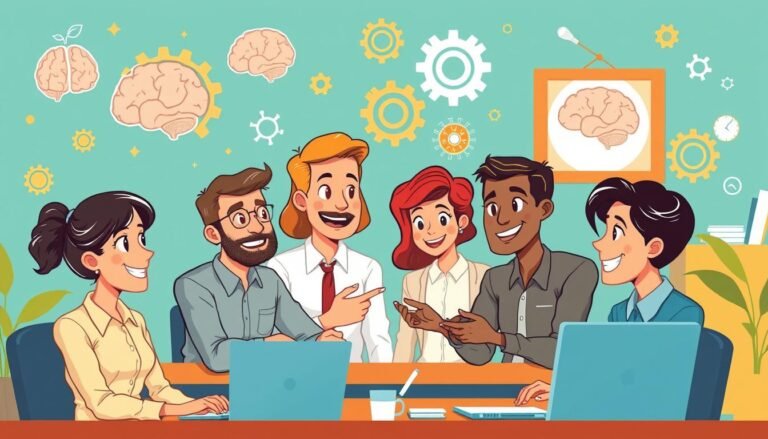Workforce Planning 101: A Psychological Approach to Predicting Talent Needs
Can your company predict its future talent needs with precision? Workforce planning is more than just a buzzword; it’s a crucial strategy for business success. It combines talent management and employee forecasting to ensure your organization has the right people in the right roles at the right time.
Imagine a world where your company always has the perfect mix of skills and talent. That’s the power of effective workforce planning. It’s not just about filling positions; it’s about strategically shaping your organization’s future.
In today’s fast-paced business world, workforce planning is your secret weapon. It helps you stay ahead of the curve, balancing labor supply and demand while keeping costs in check. By focusing on this critical aspect of talent management, you’re not just reacting to change – you’re driving it.
Key Takeaways
- Workforce planning aligns organizational needs with people strategy
- It involves predicting and preparing for future talent needs
- Effective planning can reduce costs and improve employee retention
- It informs various HR practices, from recruitment to career development
- Strategic workforce planning combines numerical data with strategic frameworks
- Successful implementation requires organization-wide communication and stakeholder involvement
Introduction to Workforce Planning
Workforce planning is key for companies to match their labor needs with available talent. It ensures the right people with the right skills are in the right place at the right time. This strategic approach is vital in today’s fast-changing business world.
Definition and Importance
Workforce planning involves analyzing the current workforce and planning for future needs. It’s a growing field in human resource management, tackling issues like an aging workforce and economic changes.
The Psychological Aspect of Talent Prediction
The psychological side of workforce planning looks at employee behaviors and motivations. This helps predict talent needs and plan for the future. Skills assessment is crucial, helping organizations understand their talent pool.
Key Benefits for Organizations
Effective workforce planning brings many advantages:
- Cost savings in recruitment and productivity
- Improved talent management and succession planning
- Enhanced labor optimization and performance
- Preparedness for future challenges
- Higher employee retention and engagement
| Metric | Impact |
|---|---|
| Companies prioritizing people analytics | Over 70% |
| Organizations effectively using talent data | Only 21% |
| Companies adopting HR analytics | At least 19% |
Despite these benefits, many struggle to implement it well. Only 21% of HR leaders think their companies use talent data effectively for strategy. But, with HRIS and advanced analytics, workforce planning is becoming more accessible and essential for success.
Understanding the Organizational Strategy
Effective workforce planning starts with understanding your organization’s strategy. This is key to aligning your recruitment and resource allocation with your long-term goals. Knowing where your company is headed helps you make informed decisions about talent needs.
Your organization’s strategy is like a roadmap. It guides your workforce planning, helping you predict future skills and roles. This way, you’re prepared for any changes in business demands.
Strategic workforce planning looks ahead 3-5 years. It considers business objectives, market trends, technological advancements, and growth areas. By aligning your recruitment strategy with these, you build a workforce ready for future challenges.
This approach also optimizes resource allocation. You invest in the right talent at the right time. It’s about having the right people with the right skills in the right jobs.
“Having the right number of people with the right skills in the right jobs at the right time” – California Department of Human Resources on workforce planning
Your organizational strategy should be flexible. It needs to adapt to changing market conditions. Regular reviews keep your workforce planning aligned with your company’s evolving needs.
Analyzing Current Workforce Composition
Effective workforce planning starts with a deep dive into your current talent pool. This process involves examining skills, demographics, and performance. It helps create a comprehensive picture of your workforce.
Skills Assessment Techniques
Skills assessment is crucial for understanding your team’s capabilities. It helps identify strengths and weaknesses. This guides future training and hiring decisions.
A thorough skills gap analysis can reveal areas where your workforce excels and where it needs improvement.
Demographic Analysis
Examining workforce demographics provides insights into diversity, age distribution, and potential succession planning needs. This data helps predict future attrition rates. It informs strategies for maintaining a balanced workforce.
Performance Evaluation Methods
Regular performance evaluations are key to understanding employee productivity and potential. These assessments guide decisions about promotions, training needs, and attrition risk.
| Aspect | Importance | Methods |
|---|---|---|
| Skills Assessment | Identifies gaps and strengths | Competency tests, self-assessments |
| Demographic Analysis | Predicts future workforce needs | Age distribution, diversity metrics |
| Performance Evaluation | Guides development and retention | 360-degree feedback, goal tracking |
By combining these analyses, organizations can create a clear picture of their current workforce. This foundation is essential for effective attrition analysis and future planning. Remember, a well-understood workforce is the first step towards strategic talent management and organizational success.
Identifying Future Talent Needs
Employee forecasting is key to planning your workforce. It predicts the skills and abilities your company will need soon. This keeps you ahead and ready for market changes.
To figure out what skills you’ll need, look at tech, market trends, and how consumers behave. These insights help you plan how to find and grow your talent.
Scenario planning is a great tool. It lets you imagine different futures and how they might affect your workforce. This way, you can make plans that work for any scenario.
“Anticipating future talent needs is like playing chess. You need to think several moves ahead to stay competitive.”
Top companies use data to spot talent needs. They use analytics to understand trends and make smart talent choices. This way, they stay ahead and avoid skill shortages.
- Analyze industry trends and technological advancements
- Use scenario planning to prepare for different futures
- Leverage data analytics for informed decision-making
- Align talent strategy with long-term business goals
By focusing on forecasting and planning for the future, companies can build strong, flexible workforces. This ensures they’re ready for challenges and opportunities ahead.
Workforce Planning: A Strategic Approach
Workforce planning is key to matching an organization’s people with its goals. It looks at both long-term plans and immediate needs. This way, companies can have the right talent for today and tomorrow.
Aligning with Business Objectives
Good workforce planning starts with knowing what the organization wants to achieve. By understanding these goals, companies can figure out what skills are needed. This helps avoid having too few or too many employees, making the team work better.
Long-term vs. Short-term Planning
Workforce planning needs to balance long-term and short-term views. Long-term planning looks at future needs, like market changes and new tech. Short-term planning deals with current staffing and skills. Both are important for a solid talent plan.
Flexibility and Adaptability in Planning
In today’s fast-changing world, being flexible is crucial. Companies must adjust their plans as the market, tech, or structure changes. This keeps the workforce in sync with business needs.
By taking a strategic approach to workforce planning, companies can better their hiring, boost productivity, and cut costs. This forward-thinking helps predict talent needs, plan for the future, and stay ahead in the market.
Psychological Factors in Talent Prediction
Talent management is more than just checking skills. It looks at the psychological sides that influence how employees behave and grow. Knowing these aspects is key to predicting talent needs and creating a successful team.
Studies show that one in three top employees don’t always try their best. This highlights the need for better ways to keep them engaged.
Personality traits are important for how well someone does their job. Traits like being outgoing, friendly, open-minded, and responsible are linked to better job performance. These traits help in managing work and being productive, making them important for spotting talent.
Professionalism is also crucial. It includes how someone acts, manages time, and communicates. Employers look for these qualities because they affect how well a company does.
“Talented employees need great managers for retention in a company.” – Marcus Buckingham
Motivation is a big psychological factor in talent prediction. The Self-Determination Theory says motivation grows when three needs are met: feeling in control, being good at things, and feeling connected. Knowing these needs helps create places where talent can grow and perform well.
| Psychological Factor | Impact on Talent Management |
|---|---|
| Personality Traits | Influence job engagement and productivity |
| Professionalism | Affects organizational performance and recruitment success |
| Motivation | Drives employee engagement and retention |
| Leadership Style | Shapes employee satisfaction and performance |
By using these psychological factors in talent management, companies can predict, grow, and keep top employees better. This leads to better planning of the workforce and success for the company.
Implementing Effective Succession Planning
Succession planning is key in managing your workforce. It makes sure your team has leaders ready for important roles. Let’s look at how to build a strong talent pipeline and develop leaders.
Identifying High-Potential Employees
Finding future leaders begins with spotting talent in your team. A survey shows 84% of HR experts believe in nurturing potential successors. Look for employees who take the lead, do well in their jobs, and show leadership skills.
Leadership Development Programs
After finding promising candidates, it’s time to help them grow. Good leadership development programs are essential. They prepare employees for future roles. These programs can include:
- Mentorship opportunities (71% of HR experts recommend this)
- In-house skills training (19% suggest organizing these)
- Shadowing and stretch assignments (32% highlight their importance)
Creating Talent Pipelines
A strong talent pipeline ensures your organization is always ready for leadership changes. To build one:
- Review succession plans regularly (67% of HR experts stress this need)
- Focus on developing middle management (26% underscore this necessity)
- Embed succession planning into your company culture (44% recommend this approach)
By using these strategies, you’ll lay a solid foundation for your organization’s future leaders. Remember, effective succession planning is an ongoing effort. It needs commitment and regular checks to meet your changing needs.
Addressing Skills Gaps through Strategic Development
Skills gaps are a big problem for companies in 2024. To solve this, businesses need to be proactive in training and developing their employees. Planning the workforce strategically is essential to get, train, and update employees for new needs.
Having a detailed plan is key to overcoming skills gaps. Companies can cut labor costs by up to 50% with virtual management tools. This method saves money and makes training more flexible.
Mentorship programs are crucial in solving skills gaps. With 89% of employees feeling valued with mentors, these programs build a team culture. They provide a personalized space for learning, especially in areas like HR, acquisition, and cybersecurity.
- Use technology for skill development
- Encourage a culture of continuous learning
- Work with schools and colleges
- Start mentorship programs
- Create plans for individual growth
There’s a clear link between development chances and keeping employees. By focusing on upskilling and making personal plans, companies help employees grow. This not only solves skills gaps but also keeps employees happy and loyal.
Career pathing tools are great for helping employees learn new skills. These tools match with workforce planning and help close skills gaps. By using these strategies, companies can make sure their teams are ready for the future.
Leveraging Data Analytics in Workforce Planning
Data analytics changes how we plan our workforce. Companies use predictive models to guess who they’ll need next. This way, they make better choices about their people.
Predictive Modeling Techniques
Predictive models help HR teams see what they’ll need in the future. They look at employee data to spot trends like who might leave and what skills are missing. This lets companies get ahead in finding and growing talent.
AI and Machine Learning Applications
AI and machine learning are changing workforce planning. They can handle huge amounts of data to find complex patterns. They can guess how well employees will do, suggest the best team setups, and even plan out careers.
Interpreting Workforce Data
It’s key to understand workforce data well. HR folks need to know about things like how happy employees are, how productive they are, and what skills they have. This helps make smart choices about who to hire, train, and how to use resources.
| Data Point | Importance | Application |
|---|---|---|
| Demographics | High | Diversity planning |
| Attrition likelihood | Critical | Retention strategies |
| Competency gaps | Vital | Training programs |
Companies that use data analytics in planning their workforce get ahead. They make better hiring choices, create specific training plans, and plan for the future. This focus on data helps them stay ready for the changing business world.
Overcoming Challenges in Workforce Planning
Workforce planning can be tough. Many companies face quick changes in business and tech. Only 52% of firms use a company-wide approach to plan their workforce. This shows room for better talent management.
Change management is crucial for successful planning. It helps teams adjust to new ways of working. But, it’s not simple. Poor data quality and unclear roles often slow things down. Just 22% of businesses are happy with their current planning tools.
To overcome these challenges, companies need to be flexible. They should watch workforce trends and update plans often. It’s important for HR, managers, and other teams to work together. With the right approach, firms can save costs, meet goals, and boost growth through smart workforce planning.
Source Links
- CIPD | Workforce planning | Factsheets
- How to Create a Data-Driven Approach to Workforce Planning | myHRfuture
- What is workforce planning, and why is it important?
- An introduction to workforce planning
- Purpose and Stages of Workforce Planning
- Blog post >> Visit the Paycom blog to learn more
- Strategic Workforce Planning 101: Framework & Process
- Business Strategy and Workforce Planning
- Practicing the Discipline of Workforce Planning
- Workforce Planning: The Complete Guide to Optimizing Your Team
- Revolutionize Your Talent Management Strategy with Workforce Planning
- Talent Strategy in Workforce Planning [Integrated Approach]
- Planning a Strategic Approach
- Strategic Workforce Planning: A Comprehensive Guide
- The Impact of Psychology on Talent Management
- Psychological Factors in Recruitment
- The Psychology of Talent Management: Motivation and Retention
- Council Post: 20 Strategies For Navigating Effective Succession Planning
- USGS Workforce and Succession Planning
- 5 tips for implementing effective succession planning – Learned
- 5 Strategies for Addressing Skills Gaps in 2024
- Addressing and closing critical skills gaps in the federal workforce – Federal News Network
- How to Leverage Workforce Analytics & HR Data | PeopleScout
- The Role of Data and HR Analytics In Workforce Planning | myHRfuture
- Combat Workforce Planning Challenges
- Overcoming Strategic Workforce Planning Challenges | eQ8
- The key challenges of strategic workforce planning







